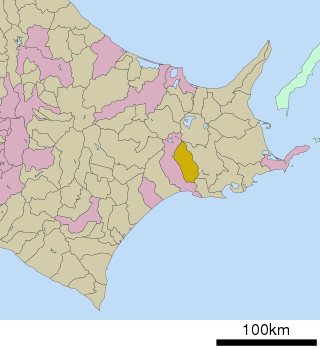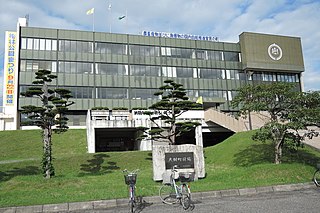
Wakkanai is a city located in Sōya Subprefecture, Hokkaido, Japan. It is the capital of Sōya Subprefecture. Wakkanai is home to Japan's first nursing home built inside the central train station of its city, a novel approach to caring for Japan's growing elderly population that has since been imitated in several other cities.

Abashiri is a city located in Okhotsk Subprefecture, Hokkaido, Japan.

Nemuro is a city and port located in Nemuro Subprefecture, Hokkaido, Japan. It is the capital city of Nemuro Subprefecture. Much of the city lies on the Nemuro Peninsula. As of February 29, 2012, the city has an estimated population of 29,087, with 12,966 households, and a population density of 56.74 persons per km2. The total area is 512.63 km2 (197.93 sq mi).

Akan is a district in Kushiro Subprefecture, Hokkaido, Japan. It includes Akan National Park, which has many dormant volcanoes.

Shiraoi is a town located in Iburi, Hokkaido, Japan. As of September 2016, the town had a population of 17,759. It was established in 1867 by the feudal lords of Sendai. Most of the area of the town is forested and parts lie within the Shikotsu-Tōya National Park.

Taiki is a town located in Tokachi Subprefecture, Hokkaido, Japan.

Ashoro is a town located in Tokachi Subprefecture, Hokkaido, Japan.

Akan was a town located in Akan District, Kushiro Subprefecture, Hokkaido, Japan.

Shiranuka is a district located in western Kushiro Subprefecture, Hokkaido, Japan.

Kushiro Province was a short-lived province in Hokkaidō. It corresponded to modern-day Kushiro Subprefecture and part of Abashiri Subprefecture.

Shiranuka is a town located in Kushiro Subprefecture, Hokkaido, Japan. As of September, 2013, it has an estimated population of 8,910, and an area of 773.74 km2. The population has fallen significantly in recent years.

Onbetsu was a town located in Shiranuka District, Kushiro Subprefecture, Hokkaido, Japan.

Rausu is a town located in Nemuro Subprefecture, Hokkaido, Japan. As of September 30, 2016, it has an estimated population of 5,395, and an area of 397.88 km2.
In 1869, the island of Hokkaido, Japan was divided into 11 provinces and 86 districts. The majority of Japan's former provinces were converted into prefectures by the Meiji government between 1870 and 1876.

Nemuro Main Line is a railway line in Hokkaido operated by Hokkaido Railway Company, connecting Takikawa Station in Takikawa and Nemuro Station in Nemuro, including Obihiro and Kushiro. Higashi-Nemuro is the most easterly situated station on the Japanese rail system.

National Route 336 is a national highway connecting Urakawa, Hokkaido and Kushiro, Hokkaido in Japan.

Bus Center-mae Station is a metro station in Chūō-ku, Sapporo, Hokkaido, Japan. The station is numbered T10.

The island of Hokkaidō is located in the north of Japan, near Russia. It has coastlines on the Sea of Japan, the Sea of Okhotsk, and the Pacific Ocean. The center of the island is mountainous, with volcanic plateaux. Hokkaidō has multiple plains such as the Ishikari Plain 3,800 km2 (1,500 sq mi), Tokachi Plain 3,600 km2 (1,400 sq mi), the Kushiro Plain 2,510 km2 (970 sq mi) and Sarobetsu Plain 200 km2 (77 sq mi). Hokkaidō is 83,423.84 km2 (32,210.12 sq mi) which makes it the second-largest island of Japan.

The 1993 Kushiro–Oki earthquake was one of two large earthquake to strike the Japanese island of Hōkkaido within the same year. The earthquake with a magnitude of 7.6 Mw or 7.8 MJMA struck at 11:06 UTC or 08:06 pm JST on January 15 near the town of Ashoro. Shaking reached a maximum intensity of IX (Violent) on the Mercalli intensity scale, causing considerable damage, and was felt throughout the island, into northern Honshu, Sakhalin, and the Kuril Islands. As a result of the tremors, two people were killed and more than 600 were wounded.
The Nemuro Belt is the easternmost tectonic unit or terrane of Hokkaidō, Japan. The boundary with the Tokoro Belt to the west is marked by the Abashiri Tectonic Line (網走構造線), which runs from the area of Abashiri on the north coast to that of Urahoro on the south coast, the southern portion coinciding with the Urahoro Fault (浦幌断層). The belt is composed of volcanogenic sediments and volcanic rocks — for the most part, basalt and andesites; these may be remnants of an island arc that took shape over an "east or southeast dipping intraoceanic subduction zone". As dated by potassium–argon geochronology and radiolarians, the oldest sequences are Campanian‐Maastrichtian. The belt has rotated counterclockwise some 15–25° since the Late Cretaceous.




































